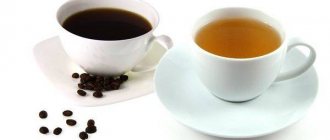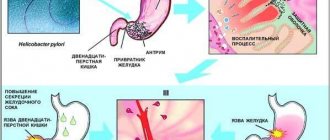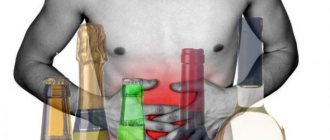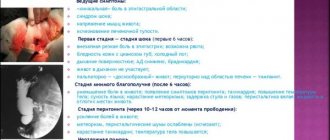The formation of ulcers in the digestive tract is a scourge for humans. Pathology is especially often diagnosed in the stomach cavity and on the walls of the duodenum. The disease is characterized by the formation of small wounds on the mucous membrane of the organ, which without treatment can destroy all layers of the wall in the affected organ.
Treatment of gastric and duodenal ulcers is based on medications. The treatment regimen is determined by the reasons that provoked the pathology.
Causes
The internal environment of the main organs of the digestive tract is most often in a state of delicate balance between high acidity and protective factors that do not allow the mucous surface to be digested by hydrochloric acid. For various reasons, this protection may not work and ulcers occur against the background of high acidity.
Experts determine the causes of ulcers by the following factors:
- Helicobacter pylori. The pathogenic bacterium produces enzymes that destroy the protective mucous layer.
- Unhealthy diet, which is mostly dominated by smoked, spicy and savory foods. Various vitamins are missing from the diet. Drinking coffee, alcohol and carbonated drinks has a negative effect on the mucous surface.
- Medicines such as non-steroidal anti-inflammatory drugs, which some patients need to take for a very long time.
- Stress. The result of constant overexertion is a dysfunction of the autonomic nervous system. With this pathology, the tone of the vagus nerve increases. This spasms the blood vessels that envelop the stomach. Normal tissue nutrition is disrupted, necessary microelements and vitamins are not supplied, after which damage to the mucous surface begins.
Antiprotozoal and antibacterial agents
Amoxicillin, Tetracycline, Metronidazole, Trichopolum, Klacid, Tinidazole, Fazizhin are prescribed to suppress the viability of Helicobacter pylori.
Drug treatment of duodenal ulcers is based on antibacterial drugs combined with antisecretory or bismuth-containing agents. The remaining drugs play a minor auxiliary role in antiulcer therapy.
Prokinetics and antacids
Motilium, Coordinax, Cerucal improve the movement of food in the intestines, eliminating feelings of nausea, preventing vomiting. Remedies for duodenal ulcers are prescribed when there is a feeling of fullness and heaviness in the stomach. Prokinetics are prohibited when the gastric outlet of the pylorus is narrowed.
Gastric and duodenal ulcers are a dangerous disease with stages of exacerbation and remission. If you have a diagnosis such as an ulcer, it is impossible to get by with one or two drugs. Therapeutic therapy is complex, and the attending physician prescribes a combination of the best medications, folk remedies and diet therapy.
Treatment of gastric and duodenal ulcers with medications should be prescribed based on the severity of the disease, symptoms, and individual characteristics of the body.
The selection of a suitable medicine for an ulcer is based on the following principles:
- patient's age;
- health status;
- duration of illness;
- location of erosions;
- individual intolerance to certain drugs.
With the help of a complex of drugs for stomach and duodenal ulcers, treatment solves the following problems:
- liquidates;
- restores the intestines and its microflora, peristalsis;
- improves gastric motility;
- relieves the inflammatory process;
- promotes healing of erosions;
- improves the production of enzymes and gastric secretions.
The main cause of duodenal and gastric ulcers is the bacterium Helicobacter pylori. Other pathogenic effects on the mucous membrane, as a rule, do not lead to the formation of erosions. Monotherapy for this disease is powerless.
Therapy
In case of ulcerative pathology, you should never self-medicate, since the pathology is very dangerous for the body. Therefore, when the disease is diagnosed, the patient is immediately prescribed inpatient therapy. The prohibition to treat an ulcer at home is associated with its transition to an acute form, since it is at this stage that the disease is usually determined.
In a hospital setting, the patient is immediately determined by the procedure for the treatment course of a peptic ulcer, the scheme of which is aimed at restoring the damaged area. For a complete recovery, the patient needs complete emotional and physical rest.
Drug treatment of stomach ulcers includes the following groups of drugs:
- Antisecretory drugs;
- Antacids.
- Medicines containing bismuth;
- Prokinetics;
- Antibiotics and antiprotozoal drugs;
- Vitamins.
When choosing a treatment course for an ulcer, the effects of individual medications should be taken into account. Some of them combine the ability to neutralize stomach acidity and form a protective layer. Taking this into account, you can save money and minimize the harmful effects of individual components on the entire body.
Complete list of medications for stomach ulcers
Antibiotics:
- Clarithromycin. Semi-synthetic antibiotic from the macrolide group. A direct descendant of erythromycin, it is distinguished by a hundred times greater resistance to the destructive effects of hydrochloric acid, more complete and rapid absorption, good distribution in tissues and a long half-life. Due to this, clarithromycin is superior to erythromycin and is recommended as the main antibiotic for the treatment of gastric ulcers;
- Amoxicillin. Semi-synthetic antibiotic of the penicillin group. Unlike penicillin, it is resistant to the corrosive effect of gastric juice, is absorbed almost completely (93%), spreads faster through tissues and fluids, covers the body more completely and remains in it longer, which makes it possible to prescribe amoxicillin for peptic ulcers twice, not four times a day. day;
- Metronidazole. Antimicrobial and antiprotozoal drug with a very wide spectrum of action. One of the oldest, most reliable and effective antibiotics, it is part of the group of vital drugs. Metronidazole is a synthetic analogue of azomycin, a natural antibiotic produced by bacteria of the genus Streptomycetes. Harmful microorganisms and protozoa interact with metronidazole, resulting in the restoration of its 5-nitro group. And it, in turn, destroys the DNA of parasites and microbes;
- Tetracycline. Antibiotic from the tetracycline group. It has a bacteriostatic effect, that is, it disrupts the interaction between ribosomes and transfer RNAs, as a result of which protein synthesis by bacterial cells is suspended and they die. Tetracycline is active against many gram-positive and gram-negative microorganisms, as well as against most enterobacteria, including Helicobacter pylori.
Histamine receptor blockers:
- Ranitidine. A drug of the second generation of histamine blockers. Reduces the activity of pepsin (a digestive enzyme responsible for the breakdown of proteins). Normalizes the pH level in the stomach, inhibits the synthesis of hydrochloric acid. Depending on the dosage, it protects the mucous membrane from the destructive effects of excess acidity for 12-24 hours;
- Nizatidine. A drug of the second generation of histamine III receptor blockers. Suppresses both the own synthesis of hydrochloric acid by the walls of the stomach and excess synthesis provoked by acetylcholine, histamine and gastrin - enzymes and mediators. Significantly reduces pepsin hyperactivity and keeps the pH level in a state of physiological norm for 12 hours after administration;
- Roxatidine. A second generation drug of histamine H2 receptor blockers. Inhibits the activity of pepsin, normalizes the acid-base balance of the stomach, reduces the secretion of hydrochloric acid caused by food, gastrin, histamine, acetylcholine, and also suppresses the basal synthesis of gastric juice. It is quickly absorbed and acts within an hour after administration. The effect lasts from 12 hours to one day, depending on the dosage;
- Famotidine. It is also a second generation drug of histamine H2 receptor blockers. Inhibits both basal and externally triggered secretion of hydrochloric acid by the cells of the gastric mucosa. Thus, it well protects the patient’s body from the unwanted effects of pepsin, histamine, gastrin and acetylcholine;
- Cimetidine. The drug is the first generation of histamine III receptor blockers, but still has not lost its relevance. It also regulates the pH level in the stomach well, inhibits the synthesis of hydrochloric acid and suppresses the activity of the pepsin enzyme. It is cheaper than the above-mentioned modern analogues, but is considered less effective due to its short period of continuous action (6-8 hours).
Proton pump inhibitors (PPIs):
- Lansoprazole. Inhibitor of H+-K+-ATPase, an enzyme responsible for accelerating the exchange of hydrogen ions. Regardless of the reasons for hypersecretion of hydrochloric acid, lansoprazole inhibits its production at the final stage, that is, immediately before release into the gastric cavity;
- Omeprazole. It also inhibits the action of the proton pump by inhibiting the activity of the enzyme H+-K+-ATPase. Hydrogen ions penetrate less well between the membranes of the cells of the gastric mucosa, and this interferes with the production of gastric juice. Moreover, it does not matter what exactly provokes hypersecretion of hydrochloric acid - the intake of food or the action of enzymes and mediators;
- Rabeprazole. Better known under the brand name “pariet”. This drug not only inhibits the secretion of hydrochloric acid, blocking the action of H+-K+-ATPase, but also has a detrimental effect on Helicobacter pylori, the culprit of stomach ulcers. Rabeprazole begins to act an hour after administration and protects the mucous membrane for up to two days in a row;
- Esomeprazole. A drug that is a dextrorotatory isomer of omeprazole and has a similar effect. It also inhibits the synthesis of hydrochloric acid at the last stage due to the deterioration of hydrogen exchange between the membranes of the cells of the gastric mucosa. Being a weak base, esomeprazole is activated in the acidic environment of the parietal tubules and suppresses the action of the proton pump.
Gastroprotectors, anabolics and reparants:
- Sucralfate. The drug has antiulcer, adsorbent, enveloping, antacid and protective effects. It has virtually no effect on the healthy mucous membrane, and in conditions of increased acidity of the diseased stomach, it breaks down into sucrose sulfate and aluminum, which allows mucus proteins to bind and form a strong protective film in places of ulceration. After taking sucralfate, the stomach walls receive protection for 6 hours from excess hydrochloric acid, pepsin, waste products of harmful bacteria and bile released from the pancreas;
- Solcoseryl. Powerful reparant and cytoprotector. Restores the gastric mucosa, promotes the healing of ulcers, improves cellular metabolism. It is produced from the blood of dairy calves and is a hemodialysate with a molecular weight of 5000 D. The potential of solcoseryl has not yet been fully studied, however, the use of this drug at the stage of healing of a stomach ulcer, that is, after the active antimicrobial phase, gives exceptionally good results;
- Enprostil and misoprostol are synthetic analogues of prostaglandin E2 and E1, respectively. These substances are similar to hormones and are produced in almost all tissues of the human body. Prostaglandins are mediators of allergy and inflammation, they regulate blood pressure, normalize muscle tone, reduce gastric acidity and inhibit the secretion of gastric juice;
- Biogastron. The active ingredient of this drug is carbenoxolone, a synthetic analogue of glycyrrhizic acid. Scientists extract this valuable material from licorice root. Biogastron has a pronounced anti-inflammatory effect and is used to treat ulcerations on the mucous membrane of the mouth, esophagus and stomach. The drug is well known abroad, but is rarely used in Russia, although it has great potential;
- Actovegin. An effective reparant and antihypoxic agent. Like solcoseryl, it is made from blood and is a hemodialysate with a molecular weight of 5000 daltons. Ultrafiltration makes Actovegin able to penetrate cell membranes, improve the absorption of oxygen and glucose and ensure rapid regeneration of damaged and inflamed tissues;
- Bismuth tripotassium dicitrate. The most optimal bismuth preparation for the treatment of stomach ulcers. In conditions of high acidity, it quickly forms a protective film that covers damaged areas of the mucous membrane. In addition, tripotassium bismuth dicitrate enhances the production of prostaglandin E2 and inhibits the activity of Helicobacter pylori, which causes peptic ulcers;
- Amigluracil. An effective anabolic and reparative. Accelerates the synthesis of proteins and amino acids, promotes the healing of ulcers and wound surfaces, improves immunity and helps the body independently cope with infections by enriching the blood with immune cells. Used successfully at the final stage of recovery after gastric and duodenal ulcers;
- Methyluracil. Also a popular immunostimulant, anabolic and reparative. Stimulates the synthesis of leukocytes, accelerates nucleic acid metabolism, promotes rapid regeneration and epithelization of damaged tissues and mucous membranes. The anti-inflammatory effect of methyluracil is explained by its inhibitory effect on proteolytic enzymes. At the final stage of treatment of stomach ulcers, the drug helps scarring and cell renewal;
- Sodium oxyferriscarbon. Anti-inflammatory, analgesic and wound-healing drug based on iron with the addition of sodium salts and alloxanic acid. Used to treat peptic ulcers of the esophagus, small and duodenal intestines, as well as gastric ulcers;
- Romazulan. A chamomile-based herbal medicine that has a complex effect: relieves spasms, relieves pain, kills germs and stimulates the healing of wounds and ulcers. Romazulan solution is used both externally, for skin lesions, diseases of the oral cavity and genitourinary tract, and internally, diluted with water, for the treatment of peptic ulcers and gastritis;
- Histidine hydrochloride. The drug is an amino acid, which, when it enters the body, undergoes a decarboxylation reaction, resulting in the formation of histamine, a mediator that has a multifaceted effect on the body. Histamine stimulates the production of epinephrine, stimulates smooth muscle, increases the permeability of the vascular walls, increases heart rate and causes the stomach to produce more gastric juice, and in some types of gastric ulcer this is necessary.
Anticholinergics:
- Gastrocepin. The active substance - pirenzepine - belongs to the group of M1-cholinergic receptor blockers, but unlike atropine, the most famous representative of this group, it does not inhibit the activity of cholinergic receptors of the heart, eyes, salivary glands and other organs, but only affects the gastric mucosa, causing it produces less hydrochloric acid and pepsinogen;
- Buskopan. The drug has a blocking effect on M-cholinergic receptors of the stomach, kidneys, gall and bladder, and also works as an antispasmodic. Buscopan relieves spasms of smooth muscles and slightly reduces the level of gastric juice secretion, which allows symptomatic relief of the condition of patients with gastric ulcer;
- Platyfillin. It blocks M-cholinergic receptors in internal organs and eyes, approximately 8 times weaker than atropine, and also blocks H-cholinergic receptors to some extent. It beats atropine due to the fact that it causes tachycardia less often. Platiphylline has an antispasmodic effect on the walls of the stomach and intestines, dilates blood vessels and lowers blood pressure;
- Metacin. Also refers to milder M-cholinergic receptor blockers than atropine. It effectively reduces the tone of the gallbladder and bladder, relieves spasms and eliminates pain in the stomach, suppresses the secretion of gastric juice, sweat, saliva, and normalizes blood pressure. Less common than atropine, it causes unwanted changes in heart rate, dilated pupils and increased intraocular pressure;
- Etpenal. Blocker of both types of cholinergic receptors - “H” and “M”. An effective local anesthetic that has a good effect on both the central and peripheral nervous systems. Etpenal is used for the symptomatic treatment of stomach ulcers, as well as bronchial asthma and Parkinson's disease, as it relieves spasms and reduces tremors.
Antacids:
- Almagel. An adsorbent, enveloping and analgesic medicine that is well known to all ulcer sufferers. Almagel protects the gastric mucosa from the destructive effects of excess hydrochloric acid and pepsin, absorbs toxic waste products of bacteria and interferes with the absorption of phosphates. Thus, it does not treat a stomach ulcer, but helps relieve its painful symptoms and reduce the harm caused by the inflammatory process to the patient’s body as a whole;
- Maalox. Antacid preparation based on magnesium and aluminum hydroxides. Maalox reacts with hydrochloric acid and neutralizes its excess, and repeated, compensatory secretion does not occur. This drug normalizes the pH level and protects the gastric mucosa, but, like Almagel, does not eliminate the very cause of peptic ulcer;
- Gastal. A more advanced, combined antacid, which, in addition to magnesium and aluminum hydroxides, contains magnesium carbonate. Immediately after administration, it allows you to artificially maintain a physiologically normal pH level in the stomach for two hours - 3.5, by neutralizing excess hydrochloric acid. It does not cure stomach ulcers, but it relieves pain and heartburn;
- Phosphalugel. Antacid preparation based on aluminum phosphate. It has a more pronounced and long-lasting effect than the above medications of the same type. Phosphalugel not only neutralizes excess hydrochloric acid, but also suppresses the activity of the enzyme pepsin. It reliably envelops the walls of the stomach, creating a protective barrier for irritants, but does not have a harmful effect on Helicobacter, therefore it can only be used for symptomatic relief of the condition of patients with peptic ulcer;
- Sodium bicarbonate. Baking soda is the simplest and most affordable antacid. A solution of soda helps relieve heartburn and stomach pain due to gastritis and ulcers, and is also used to combat acidosis caused by general intoxication of the body or diabetes.
On the subject: List of antacids, their action, features
Antiemetics:
- Motilium. The active ingredient is domperidone - the opposite of dopamine. The drug blocks the activity of dopamine receptors and increases the tone of the lower esophageal sphincter, accelerates the movement of food through the digestive tract, and stimulates gastric and intestinal motility. Motilium has no effect on the secretion of gastric juice; it simply relieves attacks of nausea and vomiting during gastritis and stomach ulcers;
- Cerucal. A drug that prevents the transmission of nerve impulses through visceral channels from dopamine receptors to the vomiting center in the brain, and also stimulates intestinal motility, increases the tone of the lower esophageal sphincter and promotes the vigorous movement of food through the digestive tract. Thus, even if there are objective reasons for vomiting, it can be avoided;
- Metoclopramide. The drug blocks dopamine and serotonin receptors, due to which it is possible not only to stop attacks of vomiting, but also to stop hiccups and avoid diarrhea, which can be a side effect of food moving too quickly from the stomach to the rectum. Metoclopramide does not affect secretory functions in any way, but there is not yet a sufficiently substantiated medical opinion that this drug promotes the healing of stomach ulcers.
Antispasmodics:
- Galidor. The active ingredient - bencyclar - is a myotropic antispasmodic, a blocker of calcium channels, serotonin receptors and sympathetic nerve ganglia. It perfectly relieves spasms of blood vessels and smooth muscles, increases the elasticity of red blood cells, lowers blood pressure, but may slightly increase the heart rate. Halidor in large doses is considered as a tranquilizer. For stomach ulcers, it is indicated as an anesthetic;
- Dibazol. Myotropic antispasmodic, benzimidazole derivative. It has a smoothing effect on the muscles of internal organs, blood vessels and capillaries, normalizes blood pressure, dilates blood vessels in the brain and accelerates the transmission of nerve impulses between synapses. It perfectly relieves headaches and muscle pain, but it does not last long, so when treating stomach ulcers, more advanced and modern antispasmodics are usually prescribed;
- Papaverine. Calcium channel blocker, mild myotropic antispasmodic. Dilates blood vessels and capillaries, reduces blood pressure and smooth muscle tone, relieves pain in the internal organs caused by muscle spasms, but does not act for long and does not have a pronounced effect on the parasympathetic nervous system to save from severe pain due to stomach ulcers. Therefore, at present, papaverine is not considered as a reliable analgesic;
- No-Shpa. The most popular antispasmodic. The active substance, drotaverine, is very similar in structure and pharmacological action to papaverine, but has a more pronounced and long-lasting effect. No-Spa prevents the entry of calcium molecules into smooth muscle cells, thereby relieving pain during migraines, periodic female ailments and peptic ulcers. The range of applications of No-Shpa is very wide, and it is this myotropic antispasmodic that is prescribed in cases where the patient, for some reason, is contraindicated with anticholinergic drugs - drugs that better relieve pain, but are not suitable for everyone.
Treatment regimen
Experts tend to blame pathogenic bacteria for the appearance of duodenal ulcers. Therefore, therapy should be based on the elimination of pathogenic microflora in the stomach cavity. Several types of treatment are used for this.
Triple therapy
Treatment of the disease begins with three-component therapy. Elimination of infection in the gastric cavity is achieved in 80% of patients. However, side effects occur in less than 5% of patients. The duration of taking medication for ulcers is within 7-14 days. If the selected therapy is ineffective, medications are replaced by other types or quadruple therapy is prescribed.
Three-component scheme for peptic ulcer disease (option I):
- Take 120 mg of preparations with bismuth such as De-nol;
- Tinidazole can either be replaced with metronidazole. Take 250 mg;
- Tetracycline. The daily dose should not be more than 0.5 g.
Three-component therapy (Option II):
- Co-administration of omeprazole (20 mg, synonym Omez), Metronidazole (0.4 g three times a day) and clarithromycin (250 mg twice a day);
- Pantoprazole (40 mg) is combined with Amoxicillin - 1 g twice a day. Clarithromycin twice daily.
Features of taking antibiotics
It is worth familiarizing yourself in more detail with the dosage regimens of the main medications that are most often prescribed to patients with peptic ulcer disease.
A doctor may prescribe the following antibiotics to a patient:
- "Oxacillin"
. It must be taken 4 times a day. The medicine is taken 3 hours after eating. - "Amoxicillin"
. The dosage regimen is the same as the previous antibiotic. - "Clarithromycin"
. It is taken 2 times a day. - "Tetracycline"
. You need to drink the medicine half an hour before your planned snack 4 times a day.
Antibiotic treatment should be continued for at least 5 days, but no more than 10.
Quad therapy
This therapy for ulcers is also called four-component therapy and is a second-line treatment. Quad therapy is considered a more effective method than triple therapy. However, experts do not recommend using it immediately. Since bacteria are highly resistant to various drugs, treatment of the ulcer should begin with the first regimen. And only if this therapy does not bring results, move on to the second.
The quadruple therapy regimen includes medications such as De-nol, H2 blockers or proton pump blockers, several types of antibiotics and antibacterial agents. Evaluation of the treatment received is carried out using several diagnostic methods no earlier than after 4-5-6 weeks.
Dietary recommendations for gastric and intestinal ulcers
If you have a stomach or duodenal ulcer, special attention should be paid to a proper diet, because this is an important component of proper treatment.
You can eat foods that are gentle on the mucous membranes of the stomach and duodenum. These dishes include:
- soups, dairy, cereal or vegetable, soups with weak meat and chicken broth are also allowed;
- liquid porridge (with water or milk);
- thoroughly cooked meat;
- boiled or steamed fish.
Steam soufflés made from meat, chicken and fish are also often included in the diet.
Milk and dairy products are allowed, you can eat eggs - they are eaten in the form of a steam omelet, or you can eat them soft-boiled. They eat bread that was baked yesterday. Drinks allowed include weak tea and jelly.
Histamine receptor blockers
These are effective drugs that are prescribed to patients for the treatment of diseases of the gastrointestinal tract. After use, a decrease in the production of hydrochloric acid occurs as a result of blocking histamine receptors. Medicines belong to the group of antisecretory drugs. Patients are prescribed the following medications:
Ranitidine. This is a second-generation drug that can reduce the activity of pepsin (a digestive enzyme responsible for the breakdown of proteins in the body). As a result of treatment, the balance in the stomach is normalized and the synthesis of hydrochloric acid is inhibited. The dosage is selected for patients individually. When the active component begins to act in the stomach, the mucous membrane is protected from the negative effects of excess acidity.- Nizatidine. It helps suppress excessive amounts of hydrochloric acid, which is produced by neurotransmitters and enzymes. Already after the first application, a decrease in pepsin occurs.
- Roxatidine. The activity of pepsin is inhibited, the acid-base balance in the stomach is normalized, and the active secretion of hydrochloric acid is reduced. The drug is rapidly absorbed, so a positive effect is observed within an hour after administration.
- Famotidine. It helps suppress the basal secretion of hydrochloric acid. The body is reliably protected from the negative effects of histamine, pepsin, gastrin, and acetylcholine.
- Cimetidine. This is a drug that has a less pronounced effect due to its short duration of action. The medicine helps regulate the optimal level of acidity in the body and helps reduce the negative impact on the stomach walls due to hydrochloric acid.
The drug is selected by the doctor after receiving the results of the analysis and examination. Patients should not choose analogues on their own. These medications have contraindications, which the gastroenterologist will take into account when choosing treatment.










